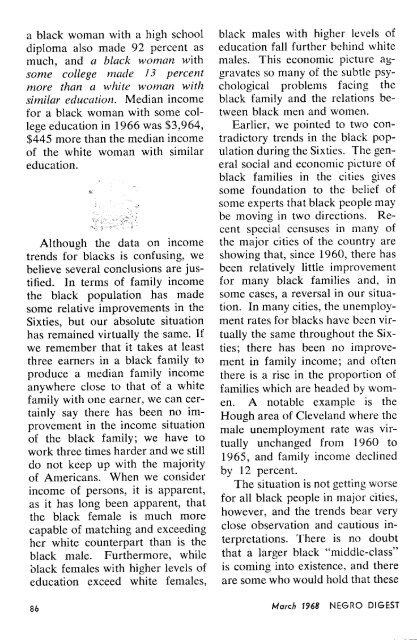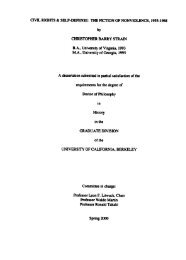Negro Digest - Freedom Archives
Negro Digest - Freedom Archives
Negro Digest - Freedom Archives
Create successful ePaper yourself
Turn your PDF publications into a flip-book with our unique Google optimized e-Paper software.
a black woman with a high school<br />
diploma also made 92 percent as<br />
much, and a black woman with<br />
some college made 13 percent<br />
more than a white woman with<br />
similar education . Median income<br />
for a black woman with some college<br />
education in 1966 was $3,964,<br />
$445 more than the median income<br />
of the white woman with similar<br />
education .<br />
Although the data on income<br />
trends for blacks is confusing, we<br />
believe several conclusions are justified<br />
. In terms of family income<br />
the black population has made<br />
some relative improvements in the<br />
Sixties, but our absolute situation<br />
has remained virtually the same . If<br />
we remember that it takes at least<br />
three earners in a black family to<br />
produce a median family income<br />
anywhere close to that of a white<br />
family with one earner, we can certainly<br />
say there has been no improvement<br />
in the income situation<br />
of the black family ; we have to<br />
work three times harder and we still<br />
do not keep up with the majority<br />
of Americans . When we consider<br />
income of persons, it is apparent,<br />
as it has long been apparent, that<br />
the black female is much more<br />
capable of matching and exceeding<br />
her white counterpart than is the<br />
black male . Furthermore, while<br />
Mack females with higher levels of<br />
education exceed white females,<br />
Sb<br />
black males with higher levels of<br />
education fall further behind white<br />
males . This economic picture aggravates<br />
so many of the subtle psychological<br />
problems facing the<br />
black family and the relations between<br />
black men and women .<br />
Earlier, we pointed to two contradictory<br />
trends in the black population<br />
during the Sixties . The general<br />
social and economic picture of<br />
black families in the cities gives<br />
some foundation to the belief of<br />
some experts that black people may<br />
be moving in two directions . Recent<br />
special censuses in many of<br />
the major cities of the country are<br />
showing that, since 1960, there has<br />
been relatively little improvement<br />
for many black families and, in<br />
some cases, a reversal in our situation<br />
. In many cities, the unemployment<br />
rates for blacks have been virtually<br />
the same throughout the Sixties<br />
; there has been no improvement<br />
in family income ; and often<br />
there is a rise in the proportion of<br />
families which are headed by women<br />
. A notable example is the<br />
Hough area of Cleveland where the<br />
male unemployment rate was virtually<br />
unchanged from 1960 to<br />
1965, and family income declined<br />
by 12 percent .<br />
The situation is not getting worse<br />
for all black people in major cities,<br />
however, and the trends bear very<br />
close observation and cautious interpretations<br />
. There is no doubt<br />
that a larger black "middle-class"<br />
is coming into existence, and there<br />
are some who would hold that these<br />
March 1968 NEGRO DIGEST
















